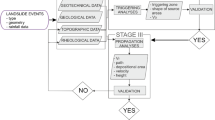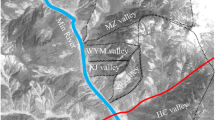Abstract
Clayey slow-moving landslides are characterized by their capability to suddenly change behaviour and release debris-flows. Due to their sediment volume and their high mobility, they are far more dangerous than those resulting from continuous erosive processes and associated potential high hazard magnitude on alluvial fans. A case of transformation from earthflow to debris-flow is presented. An approach combining geomorphology, geotechnics, rheology and numerical analysis is adopted. Results show a very good agreement between the yield stress values measured by laboratory tests, in the field according to the morphology of the levees, and by back-analyses using the debris-flow modelling code, Bing. The runout distances and the deposit thickness in the depositional area are also well reproduced. This allows proposing debris-flow risk scenarios. Results show that clayey earthflows can transform under 5-years return period rainfall conditions into 1 km runout debris-flows of volumes ranging between 2,000 to 5,000 m3.





Similar content being viewed by others
References
Ancey C (2002) Debris-flows and related phenomena. In: Balmforth N, Provenzale A (eds) Geomorphological fluid mechanics. Springer, Berlin Heidelberg New York
Colas G, Locat J (1993) Glissement et coulée de La Valette dans les Alpes de Haute-Provence. Présentation générale et modélisation de la coulée. Bulletin de Liaison des Laboratoires des Ponts et Chaussées 187:19–28
Corominas J, Moreno M (1988) Mechanism of mudflows: a case study in the Spanish Pyrenees. In: Bonnard C (ed) Proceedings of the 5th International Symposium on Landslides, Balkema, Rotterdam
Coussot P (1997) Mudflow rheology and dynamics. Balkema, Rotterdam
Coussot P, Meunier M (1996) Recognition, classification and mechanical description of debris-flow. Earth Sci Rev 40:209–227
Flageollet JC, Malet JP, Maquaire O (2000) The 3-D structure of the Super-Sauze earthflow: a first stage towards modelling its behaviour. Phys Chem Earth 25(9):785–791
Flageollet JC, Maquaire O, Martin B, Weber D (1999) Landslides and climatic conditions in the Barcelonnette and Vars basins (Southern French Alps, France), Geomorphology 30:65–78
Gasparetto P, Mosselman M, van Asch TWJ (1996) The mobility of the Alvera landslide (Cortina d’Ampezzo, Italy), Geomorphology 15:327–335
Hungr O, Evans SG, Bovis MJ, Hutchinson JN (2001) A review of the classification of landslides of the flow type. Environ Eng Geosci 7:221–238
Imran J, Harff P, Parker G (2001) A numerical model of submarine debris-flow with graphical user interface. Comput Geosci 27:717–729
Iverson RM (1997) Hydraulic modeling of unsteady debris-flow surges with solid-fluid interactions. In: Chen CL (ed) Proceedings of the 1st International Conference on Debris-Flow Hazards Mitigation. Am Soc Civil Eng, New York
Iverson RM, Reid ME, LaHusen RG (1997) Debris-flow mobilization from landslides. Ann Rev Earth Planet Sci 25:85–138
Johnson AM, Rodine JR (1984) Debris-flow. In: Brunsden D, Prior DB (eds) Slope instability, Wiley, Chichester
Laigle D, Coussot P (1997) Numerical modeling of mudflows. J Hydraul Eng 123(7):617–623
Le Mignon G, Cojean R (2002) Rôle de l’eau dans la mobilisation de glissement-coulées (Barcelonnette, France). In: Rybar J, Stemberk J, Wagner P (eds) Proceedings of the 1st European Conference on Landslides, Swets & Zeitlinger, Lisse
Malet JP, Locat J, Remaître A, Maquaire O (2004) Triggering conditions of debris-flows associated to complex earthflows. Geomorphology (in press)
Malet JP, Maquaire O, Calais E (2002a) The use of Global Positioning System for the continuous monitoring of landslides. Application to the Super-Sauze earthflow (Alpes-de-Haute-Provence, France). Geomorphology 43:33–54
Malet JP, Remaître A, Ancey C, Locat J, Meunier M, Maquaire O (2002b) Caractérisation rhéologique des coulées de débris et laves torrentielles du bassin marneux de Barcelonnette. Premiers résultats. Rhéologie 1:17–25
Malet JP, Remaître A, Maquaire O, Ancey C, Locat J (2003) Flow susceptibility of heterogeneous marly formations. Implications for torrent hazard control in the Barcelonnette basin (Alpes-de-Haute-Provence, France). In: Rickenmann D, Chen CL (eds) Proceedings of the 3rd International Conference on Debris-Flow Hazards Mitigation, Millpress, Rotterdam
Malet JP, van Asch TWJ, van Beek R, Maquaire O (submitted) Dynamic hydrological modelling of a fast moving complex landslide in the French Alps. Hydrol Proc 18 pp
Maquaire O, Malet JP, Remaître A, Locat J, Klotz S, Guillon J (2003) Instability conditions of marly hillslopes, towards landsliding or gullying? The case of the Barcelonnette basin, South East France. Eng Geol 70(1–2):109–130
Pellegrino A, Ramondini M, Russo C, Urciuoli G (2000) Kinematic features of earthflows in Southern Italy. In: Bromhead E, Dixon N, Ibsen ML (eds) Proceedings of the 8th International Symposium on Landslides. T. Telford, London
Petrascheck A, Kienholz H (2003) Hazard assessment and map** of mountain risks in Switzerland. In: Rickenmann D, Chen CL (eds) Proceedings of the 3rd International Conference on Debris-Flow Hazards Mitigation. Millpress, Rotterdam
Picarelli L (2001) Transition from slide to earthflow and the reverse. In: Proceedings of Conference on transition from slide to flow—mechanisms and remedial measures, Karadeniz Technical University, Trabzon, 25–26 August 2001
Malet JP, Remaître A, Laigle D, Locat J, Maquaire O (submitted) Cross-calibration of two debris-flow runout models on clay-shale catchments of Southeast France. In: Lacerda W (ed) Proceedings of the 9th International Symposium on Landslides, Balkema, Rotterdam 6 pp
van Beek LPH, van Asch TWJ (1996) The mobility characteristics of the La Valette landslide. In: Senneset K (ed) Proceedings of the 7th International Symposium on Landslides, Balkema, Rotterdam
Acknowledgments
This work was supported by grants from the French Ministry of Research in the ACI-CatNat contract MOTE (MOdélisation, Transformation, Ecoulement des coulées boueuses dans les marnes) and from the Centre National de la Recherche Scientifique under the INSU-PNRN contract ECLAT (Ecoulement, Contribution de LAves Torrentielles dans les basins versants marneux). Contribution INSU N°354. Contribution EOST N° 2003-40-UMR7516.
Author information
Authors and Affiliations
Corresponding author
Rights and permissions
About this article
Cite this article
Malet, JP., Maquaire, O., Locat, J. et al. Assessing debris flow hazards associated with slow moving landslides: methodology and numerical analyses. Landslides 1, 83–90 (2004). https://doi.org/10.1007/s10346-003-0005-x
Received:
Accepted:
Published:
Issue Date:
DOI: https://doi.org/10.1007/s10346-003-0005-x




